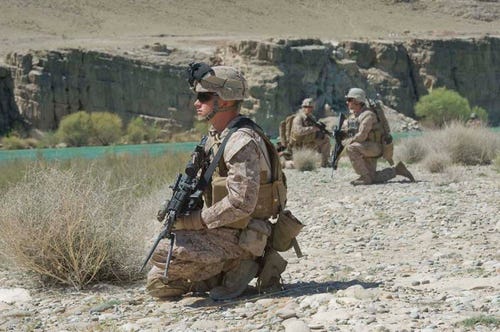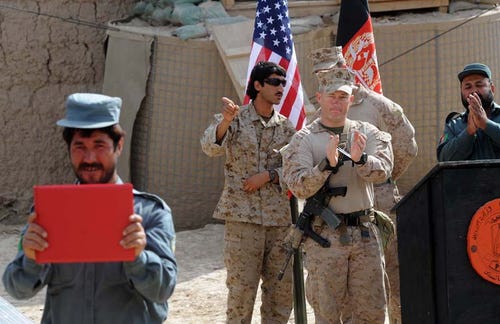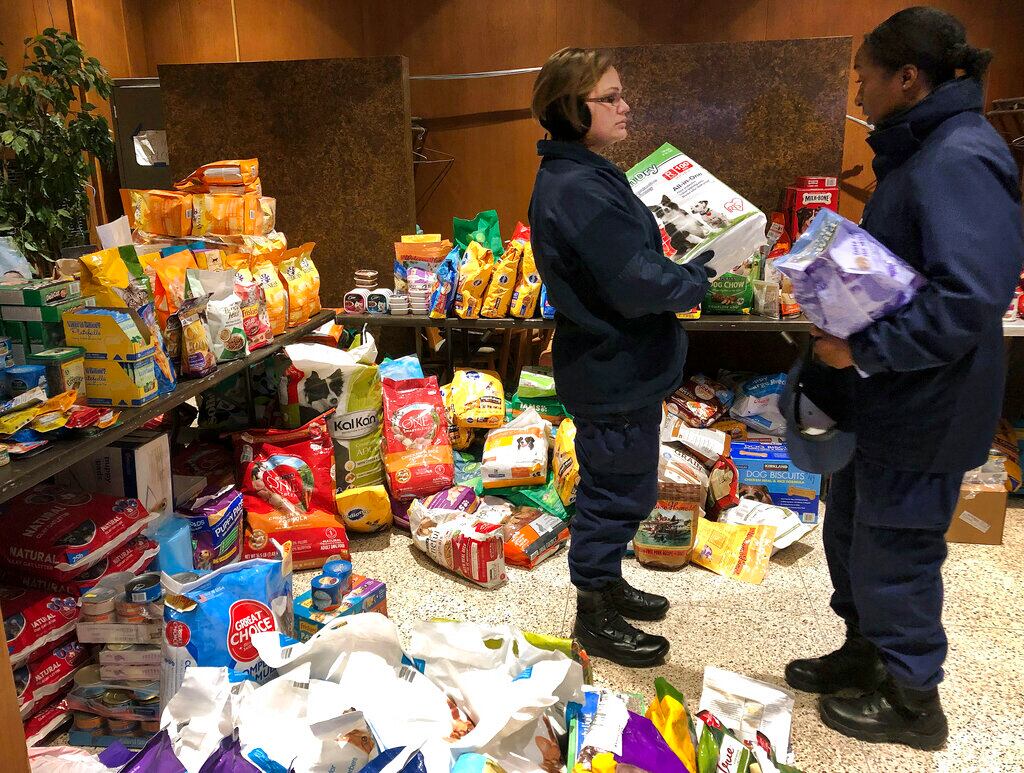source GAIA package: Sx_MilitaryTimes_M6201210204230328_5675.zip Origin key: Sx_MilitaryTimes_M6201210204230328 imported at Fri Jan 8 18:18:06 2016
KAJAKI, Afghanistan —- The attack on Forward Operating Base White House began during a sandstorm. A team of at least four insurgents targeted guard posts with 7.62mm machine-gun fire while there was limited visibility, sparking a firefight that lasted nearly an hour, Marines here said.
 The March 19 ambush on the forward headquarters of 1st Battalion, 8th Marines, out of Camp Lejeune, N.C., ended poorly for the attackers. They escaped into a cave overlooking the base, but came under heavy Marine fire and retreated off the ridges. At least one Marine was hurt, and the insurgents eventually were detained by Afghan National Civil Order Police, a paramilitary organization working with coalition forces to build security across Afghanistan.
The March 19 ambush on the forward headquarters of 1st Battalion, 8th Marines, out of Camp Lejeune, N.C., ended poorly for the attackers. They escaped into a cave overlooking the base, but came under heavy Marine fire and retreated off the ridges. At least one Marine was hurt, and the insurgents eventually were detained by Afghan National Civil Order Police, a paramilitary organization working with coalition forces to build security across Afghanistan.
 "They had a legit machine gun up there," said Lance Cpl. Josh James, a 1/8 rifleman on base at the time. "They were really laying into us."
"They had a legit machine gun up there," said Lance Cpl. Josh James, a 1/8 rifleman on base at the time. "They were really laying into us."
The incident highlights the dangers and mission here, the northernmost district in the Marine Corps' area of operations in Helmand province, where about 17,000 Marines are deployed.
Kajaki, best known for its landmark dam along the Helmand River, did not have a heavy Marine presence until October, when forces led by Lejeune's 1st Battalion, 6th Marines, launched Operation Eastern Storm. They pushed north from neighboring Sangin district to assault Taliban strongholds here and established FOB White House as their headquarters alongside a steep, rocky hill.
Marines with 1/8 took over after arriving in January, inheriting a mission that calls for training Afghan National Security Forces, keeping the Kajaki Dam safe and creating enough security for the government to establish a safe environment for the population. They work alongside Golf Battery, 2nd Battalion, 11th Marines, out of Camp Pendleton, Calif., which has manned a Kajaki fire base, FOB Zeebrugge, since the fall. Marines have operated out of Zeebrugge since 2010, when they took it over from British forces.
Security has improved in some key areas of Kajaki, but the mission is complicated by the planned withdrawal of U.S. forces from Afghanistan.
Multiple outposts and patrol bases in Kajaki already have been closed. Others have been turned over to Afghan forces, who have begun to patrol independently in some areas but still struggle with weapons discipline, logistics and other skills they must master if they are to operate on their own.
The U.S. plan calls for Marines to continue assisting with security in Kajaki this year while stressing to Afghan forces and local leaders that the Corps won't be in Afghanistan forever. That's in contrast to development efforts in Marjah, Garmser, Nawa and other Helmand districts over the past few years, where thousands of Marines deployed and civil affairs money was spent liberally to help build the government.
In Kajaki, Marines instead are acting as "player coaches," working with district leaders while stressing that the Afghans must find their own solutions to problems, said Lt. Col. Kevin Trimble, 1/8's commander.
"The whole thing is about what is 'Afghan right,' and what is 'Kajaki right,'" he said. "We're doing this fast. Is this Marjah? No. But it has never been Marjah."
Measuring progress
The landscape in the southern section of Kajaki resembles much of the Helmand communities along the river — it's rural, with temperatures climbing above 100 degrees in the summer. In northern Helmand, a series of rocky mountain ranges change the landscape significantly.
Kajaki is a farming community whose major cash crop is poppy, which is used to make heroin and other narcotics. Most of the population lives along the river and Route 611, the main highway through the region. The area around the dam is largely deserted and economically disadvantaged.
Recently, attacks across Kajaki have not been as frequent as they were in other Helmand districts within the first few months of the Marines' arrival.
The insurgency is still active, however. The most significant threat remains improvised explosive devices, which the Taliban uses to target Marines in vehicles and on foot patrol. Enemy fighters also use four-to six-man teams to ambush patrols, convoys and bases, most commonly with harassing fire from machine guns and AK47 assault rifles.
One high-profile attack occurred Jan. 18, when 1/6 was in the process of turning over the AO to 1/8. Two Marines from 1/6 — Cpls. Phillip McGeath and Chris Bordoni — died after a suicide bomber detonated a vest packed with explosives in the Sofla Bazaar, an active community with dozens of street-side shops. McGeath was killed on the scene. Bordoni succumbed to his wounds April 3. At least three Afghan policemen and 10 civilians also were killed, and nearly two dozen more were transported to the military hospital aboard Camp Bastion, part of the Camp Leatherneck military complex.
No similar attacks have occurred since then, but Marines are vigilant for the possibility. They've faced sporadic indirect fire on many of the bases and outposts in Kajaki. Insurgents have used several kinds of mortars, even taking aim at FOB White House at least once. The rounds missed badly, Marines on base said.
Still, Marine officials see cause for hope. For instance, Kajaki's district governor, Sharif Houddin Akhundzada, said recently that he wants to close the popular Sofla Bazaar in an attempt to force more merchants to use the Tangye Bazaar, said Maj. Gen. David Berger, who commands Marine ground operations in Helmand as head of 1st Marine Division (Forward). The Tangye Bazaar is closer to the district governor's headquarters along Route 611, but largely vacant and heavily damaged after years of fighting dating back to the 1980s after Russia invaded Afghanistan.
Several tribal elders in Kajaki are against the move, and have threatened to take the issue to the provincial governor, Mohammad Gulab Mangal, Berger said. Marine officials are tracking the situation, but see it as a positive sign that tribal elders are attempting to make their case to political leaders, rather than resorting to violence.
"We're just staying back," Berger said. "Nobody is shooting each other. The elders, the police chief, the district governor, these are the dynamics that have to work themselves out. As long as nobody is shooting each other, we're just watching it. This is progress, in other words."
Focus on Afghan forces
The Marines in Kajaki also are developing a long-term security plan. It would have Afghan National Army units working the fringe of population areas to prevent insurgent influence, with the paramilitary ANCOP patrolling Route 611 and the Afghan Uniform Police walking the beat in villages, said Capt. Dave Kelm, 1/8's ANSF coordinator.
The battalion has Marine advisory teams that train the Afghan Uniformed Police, and grunts continue to leave the wire in partnered patrols with Afghan soldiers. Marines working with both said they have seen improvements in Afghan forces, compared with previous deployments. Afghan troops now are more likely to do the jobs they are assigned, said Cpl. Cory Vickery, a squad leader with Alpha Company, 1/8, who deployed to Musa Qala in 2011.
"As you can see, they're manning all their posts," he said after returning from an April 11 patrol with his squad and two Marine Corps Times journalists. "It's a lot less of a hassle now. We can trust them to do a little bit more."
The battalion also has police adviser teams that work directly with the AUP, training them on the basics of patrolling, evidence handling and other police skills. Unlike other branches of the Afghan security forces, the AUP are recruited from their home districts to work there, and have shown initiative and a desire to improve, said 1st Lt. Brandon Remington, head of one of the police adviser teams.
"They've been around since 2005, but this was Taliban country," Remington said of the AUP. "They help us, and we need them to help us."
Marine forces in Kajaki also are actively broadcasting information about Taliban attacks and coalition operations on a radio station known as "FM 100," Kelm said. The "radio in a box" system uses recorded Afghan programming piped in by satellite from Helmand's capital, Lashkar Gah.
Marine officials break in with news updates in Pashto, the common language in Helmand. To promote its use, the Marines plan to hand out about 2,500 radios that can be powered by hand crank and solar technology.
In a recent example, the Marines broadcasted details about an April 10 rocket attack on FOB White House that fell short of the base and seriously wounded two boys and a middle-aged man. The casualties were medically evacuated by U.S. forces.
"It's in our interest to broadcast that kind of stuff," said Kelm, who also serves as 1/8's information operations officer. "You want to be first with the truth. Otherwise, you're always in catch-up mode."





